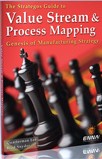Defining Production Control
Production Control coordinates multi-step processes, often with multiple products. Kanban is just one of several ways to achieve this coordination.
Methods of Production Control
Physical Linking is another way to coordinate. Here, each part in the process moves in synchronization and each step
starts simultaneously. Processes must have the same lot size and co-location.
In Broadcast, a final assembly operation builds directly to schedule. The schedule is simultaneously "Broadcast" to upstream
subassembly and supply operations. They build the needed parts in "Line-Set Order" with a small time offset for
delivery. This system does not require co-location. It does require identical lot sizes (usually one) for all processes.
Kanban scheduling systems are useful when lot sizes differ between process steps, processes are unbalanced or when distance introduces time lag or variability. These
systems slightly de-couple the processes.
Materials Requirements Planning (MRP) works from Bills Of Material (BOM), routings, inventory records and forecasts. It
plans each process step for each product, subassembly and item. The system accumulates demand for each work center and each time period. In theory, MRP allows
effective scheduling under the most difficult conditions of variability and disconnected process.
Re-Order Point (ROP) systems store each item and issue to downstream work centers on request. ROP signals a resupply when the inventory is just sufficient to cover the resupply time.
|
This ability to connect disjointed production comes with a price. MRP permits some forms of sloppy engineering. The administrative costs are high. Throughput times are long
and inventory turns low. Errors in inventory, BOM's or lead times disrupt the system. About 70%-90% of installed MRP systems do not meet their user's needs.
ROP systems are simple. They require steady and predictable withdrawal rates and predictable replenishment times. But, these conditions are rare. Typical systems have very high inventories and
experience frequent stockouts.
A Hierarchy Of Methodology
The figure below shows how the methods form a hierarchy of simplicity and flexibility. The best system is the simplest.
Where the process allows, Physical Link is the system of choice. Broadcast, Kanban, MRP and ROP follow in desirability.
A system designer would examine each process and each product group in turn. He/she attempts to apply physical linkage. If the necessary conditions do not exist and
process change is impractical, Physical Linkage is rejected and Broadcast is considered. This process follows down to the least desirable systems, MRP & ROP.
In practice, Kanban scheduling systems are often a good choice. They can be a transition between MRP and ROP approaches and Physical Linkage.
|





